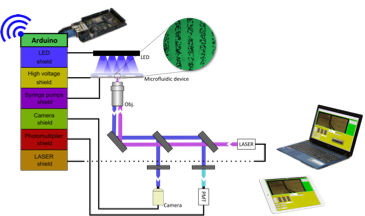Enzyme evolution in a microchip

Microfluidic for enzyme synthesis
The future viability of Australia’s chemical manufacturing industry depends on science and technology that can be exploited to generate more elaborately transformed materials. There has been great effort in in developing such materials since the last few decades (e.g. new nanoparticles and new biomaterials). However, the main bottle-neck for some of the developments is the need for screening ‘libraries’ of massive numbers (up to 1012) of candidate chemicals, biological and synthesis parameters. This could cost up to millions to billions and take several years to complete, even using the state of the art high throughput screening facilities.
The CSIRO Fluid Dynamics Group addresses this challenge by using droplet-based microfluidic technologies. Water in oil emulsion droplets are generated in microfluidic devices and act as compartmentalised picolitre reactors. These devices use millilitre samples to generate millions of microdroplets, i.e. reactions, within a few hours, unprecedented speed and low cost for developing new materials.
We have developed droplet lab on a chip platforms that are able to generate millions of monodispersed microdroplets (single or double emulsions) with very high throughput (up to ~103 drops/s), fuse droplets on the fly for adding reactants, perform chemical and biological synthesis in individual droplets, detect droplet and select droplets for desirable products.
We presents here an integrated microfluidic platform for the synthesis, screening and sorting of libraries of variants of a specific enzyme. The enzymes are synthesized inside an emulsion of microdroplet bioreactors from a DNA source using in vitro transcription and translation. Moreover, this system integrates bioreactors observation and control via an Arduino board. This interface allows the communication between camera, syringe pumps and high power supply in order to interact with the bioreactors. Therefore, each bioreactor is sorted depending on their fluorescence activity (and so, on the ability for the enzyme to be synthesised and to react with a specific substrate).

Therefore, this micro-droplet based system integrates the essential steps from the enzymes’ synthesis to the selection of the best genes (producing the highest enzyme activity) inside a single and unique device. An overview of the system will be presented as well as its limitations.
Sunday, 17 April 2011

